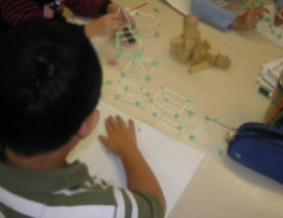
The way in which we approach mathematics has changed a lot! Instead of simply filling in the answer to 3 + 9 = ____ , students are asked to show how they got the answer, or explain their thinking. Our goal here is to recognize different types of learning and help students understand HOW they achieved a particular answer. If there is an error, it is easier now to pinpoint exactly where that error was made, instead of placing the dreaded "X" beside it with no explanation or reasoning.
Inquiry-based learning and problem solving is the focus of seeing the world through a mathematical lens. Students are given opportunities to approach problems from a variety of ways and to articulate their understanding of the processes used. Making mistakes is an accepted practice if learning from such mistakes leads to understanding and improvement. Opportunities to solve open-ended problems create interest and challenge, and encourages collaboration and articulation of ones thinking.
There is also a move away from pencil-and-paper tasks. Students are encouraged to use manipulatives such as pattern blocks, 3D solids, geo-boards, and counters to help them better understand math problems. (It's easier to understand how many faces are found on a cube when there is one right there to touch, turn and count). Kingslake has a fully stocked Math Resource Room where teachers have access to a wide range of manipulatives organized by math concept. New teaching and assessment resources have been purchased and are being implemented to support differentiated instruction by pre-assessing student understanding of concepts and then focusing on specific strategies for specific needs. Guided math groups as well as three-part lessons are used to help teachers focus their support for individual needs.
Analyzing formal and informal math assessment data help our teachers to determine annual school-wide initiatives for math improvement. Our Learning Coach helps facilitate Collaborative Inquiry teams of teachers to investigate, discuss, plan and assess improved practices and instruction.